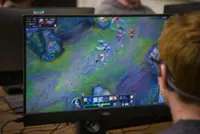In an undated image provided by Konami, a scene from the remake of Silent Hill 2. A remake of the 2001 survival horror game sands down the unwieldy combat that made it a powerful, disturbing classic. — Konami via The New York Times
The survival horror masterpiece Silent Hill 2 features some of the most ungainly combat ever included in a video game.
You play as James Sunderland, a grieving widower who has received a letter that purports to have been written by his wife.
You must make your way through a mysterious fog-enshrouded town while fending off the monsters that inhabit it, and you are barely up to the task.
Your primary means of self-defence are a length of steel pipe and a flimsy wooden plank, both of which are awkward to wield. Winding up to swing takes an unreasonably long time. If you connect, you’re left defenceless while taking a moment to recover.
When you eventually find a gun, you have little ammunition, and aiming is so delicate that you almost always miss. There’s not even much incentive to fight: Vanquished foes don’t drop items or power-ups, and defeating them doesn’t earn you experience points. Faced with an enemy in the 2001 game, it’s nearly always better just to run away.
In its remake of Silent Hill 2 that was released for the PlayStation 5 and PC this week, Polish developer Bloober Team has pointedly addressed this clumsiness.
A glowing review in IGN explains that the remake “smoothly polishes down the rough edges of the original game’s combat” by integrating an over-the-shoulder targeting system and dodge and parry movements that allow James “to nimbly sidestep around lurching enemies or the streams of acidic bile they spew”. In keeping with other modern horror games, the new Silent Hill 2 makes players feel quick, agile and powerful.
But this is not an improvement. In fact, it’s a betrayal of the original game and demonstrates a fundamental misunderstanding of what made it so compelling.
Silent Hill 2’s combat was clumsy and unwieldy by design: It put you in the shoes not of an invulnerable video game superhero, but of an ordinary guy in extraordinary circumstances, as ill-equipped to battle monsters as any one of us would be. It helped cultivate an atmosphere of oppressive, excruciating dread, in which every passing encounter with an enemy could be fatal.
Silent Hill 2 is a sequel not by story but by setting. The first Silent Hill, released for the Sony PlayStation in 1999, was about a man searching for his missing daughter, and it revolved around a demonic cult and telekinetic powers. Silent Hill 2, set in the same small town in Maine, tells the stand-alone story of the Sunderlands, a simple but emotionally complex tale about grief and shame.
“In my restless dreams, I see that town,” begins the letter that James receives at the outset of the game. “I’m alone there now, in our special place, waiting for you.” The uncanny tone is the first clue that there’s more going on here than a missing wife.
It quickly becomes clear that all is not as it seems within Silent Hill, and indeed that all is not well with James Sunderland. The town appears abandoned but he soon finds other visitors, each of whom acts strangely and largely undisturbed by the roaming monsters.
James meets a woman, Maria, who looks a lot like his wife – shades of Vertigo – and then she, too, dies, before turning up unharmed in another location, insisting that she was never even in danger. All of these encounters combine to create an air of unease. The somewhat stilted dialogue adds to the feeling that something is “off” – it’s not merely scary, but disturbing.
Everything in Silent Hill 2 is unpleasant. Sometimes, as in the films of David Lynch and the paintings of Francis Bacon – two presiding influences – the unpleasantness manifests as eerily beautiful, as in the town’s fathomless banks of purgatorial fog or the huge inferno that engulfs a seaside hotel. Other times it can be more brutal.
One of the game’s most famous boss battles is against an enemy known as “Abstract Daddy”. Drawn from the subconscious of Angela, a young woman traumatised by her childhood sexual abuse, he appears as a deformed, vaguely phallic creature trapped within the frame of a bed. It sounds trite to call monsters like these “inner demons”. But the subconscious basis of the horror gives Silent Hill 2 a rare emotional depth.
There’s one moment in particular that has stuck with me since I first played the Konami-published game on the PlayStation 2 more than 20 years ago.
James has entered the town’s historical society, a large house that has been converted into a museum. Part of the wall in one room has been knocked down, revealing a dark, narrow staircase lined on either side by coarse, heavy rock. You begin to walk down the stairs – and they don’t stop. You just keep walking, further and further down, for what feels like an eternity, tracing a seemingly endless arc like one of the “impossible” hallways in Mark Z. Danielewski’s House Of Leaves.
The moment is inspired in part by the scene in Jacob’s Ladder in which an infinite procession of hospital hallways resembles a harrowing descent into hell. Like that sequence, the historical society staircase renders a psychological – or perhaps spiritual – journey in physical space, making literal a primal, universal kind of fear.
Part of the brilliance of Silent Hill 2 is that it allows itself to linger on these moments of nonaction, of stretching out time without dialogue or story to focus on atmosphere and emotion. Its impact derives from its emphasis on these qualities rather than shootouts and chase scenes. The gameplay serves its ideas rather than the other way around.
When the original Silent Hill 2 was released, reviews criticised the clunky combat. But as Janet Malcolm once wrote of J.D. Salinger’s work, “negative contemporary criticism of a masterpiece can be helpful to later critics,” as “the ‘mistakes’ and ‘excesses’ that early critics complain of are often precisely the innovations that have given the work its power.”
It’s hard to think of a better example of this phenomenon in video games than Silent Hill 2. It’s clear now, or should be, that the game’s deliberately clunky action is one of its most significant achievements, a bold creative choice that dovetailed perfectly with the themes of the story.
Which is why the changes made by the remake are all the more disappointing. Perhaps Silent Hill 2 is now smoother and more modern. But in its imperfections, the original was genius. – The New York Times





